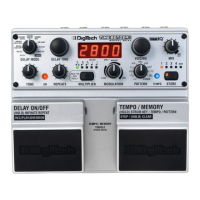18
Delay Types
The TimeBender
TM
includes 11 different delay types. Some recreate classic delays
that have remained popular for decades, while others (like Dynamic Repeats and the
TimeBender’s unique Envelope) are totally new, ready for you to try them out for the
first time.
Digital (1. )
The Digital delay provides a clean digital sound and a flat frequency response
with the tone knob at the 12 o’clock position. A limiter in the feedback path
prevents clipping and keeps the sound clean even when the Repeat knob is
turned up high. When you change the delay time in Digital delay, you’ll notice
that the old delay fades out while the new delay fades in—so the pitch of your
delayed signal remains constant.
Analog (2. Ana)
The Analog delay is based on the solid-state “bucket brigade” delays of
the 1970s. When the tone knob is at 12 o’clock, you’ll hear the substantial
high-frequency roll-off characteristic of these devices. The feedback path
includes a saturator that will introduce some distortion when the feedback signal
becomes large. When changing the delay time, you’ll notice the delay “slides” to
the new value resulting in a pitch shifted signal while the delay is moving.
Moving Head Tape (3. tAp1)
The Moving Head Tape delay is based on early (tube-based) systems that had
movable playback tape heads. Like the fixed head tape delay, the Moving Head
Tape delay also has saturation in the feedback loop and a characteristic high
frequency and low frequency roll-off. There is also a mid-boost sound across the
tone range common in tube-based systems. When changing delay time, you’ll
hear the sound of a moving tape head rather than the sound of changing the tape
speed—the pitch shift amount will depend on the size of the delay change.
Variable Speed Tape (4. tap2)
The Variable Speed Tape delay is based on early tape delays, in which the
delay was controlled by changing the speed of the tape. With the Tone knob
at 12 o’clock, you’ll hear both high frequency and low frequency roll-off. The
feedback path contains a saturator that mimics the saturation characteristics of

